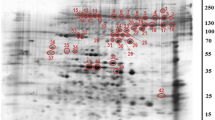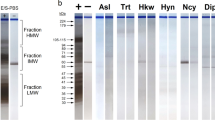Abstract
In this study, the antigenic mosaic of the vesicular fluid (VF) and hydrosoluble cyst-wall extract (CWE) ofT. crassiceps (Tc; harvested from mice) andT. saginata (Ts) metacestodes was analyzed by combined precipitation maps developed in single and bidimensional immunoelectrophorsis against the respective rabbit antiserum. Hostserum proteins demonstrated by immunodiffusion within TcVF (albumin, transferrin, IgG, and another five noncharacterized proteins), TcCWE (albumin, IgG, and six additional unknown proteins), TsVF (albumin) and TsCWE (albumin and IgG) were removed by immunoaffinity chromatography prior to immunoelectrophoretic analysis. Neither TcVF nor TcCWE contained demonstrable amounts of mouse IgM and IgA. In TcVF a total of 18 and in TcCWE a total of 36 parasitic antigens were recognized by the corresponding antiserum. In the case of TsVF and TsCWE, antiserum to the crude extract ofT. saginata larvae developed a total of 26 and 30 precipitates, respectively. Examination of the precipitation maps developed by the respective heterologous antiserum (vice-versa testing) showed that both TcVF and TsVF contained ten antigens sharing identity. For TcCWE and TsCWE, nearly the same number of shared antigens (20 and 18, respectively) could be demonstrated. For screening of IgG antibodies againstT. saginata metacestodes from heavily and moderately infected calves (n=6) by ELISA, VF and CWE antigens of bothTaenia species were found to be potent reagents; TsVF was the most sensitive antigen.
Similar content being viewed by others
References
Adams CWH, Tuquan NA (1961) The histochemical demonstration of proteinases by a gelatin-silver substrate. J Histochem Cytochem 9:469–472
Cavalan S, Rhalem A, Luffau G, Pery P (1985) Antigenic analyses of the adult worms ofNippostrongylus brasiliensis by crossed immunoelectrophoresis. Ann Rech Vet 16:305–312
Chernin J (1982) The nature of antigens common to both the metacestodes ofT. crassiceps and its laboratory host. J Helminthol 56:339–344
Crowl A (1973) Immunodiffusion, 2nd edition. Academic Press, New York London
Enyenihi UK (1970) Analysis, purification and serologic evluation of antigens for diagnosis of bovine cysticercosis and human taeniasis. J Parasitol 56:91–92
Esch GW (1964) Comparative carbohydrate metabolism of adult and larvalMulticeps serialis. J Parasitol 50:72–76
Geerts S, Kumar V, Ceulemans F, Mortelmans J (1981a) Serodiagnosis ofT. saginata cysticercosis in experimentally and naturally infected cattle by enzyme-linked immunosorbent assay. Res Vet Sci 30:288–293
Geerts S, Verfoort T, Kumar V, Ceulemens F (1981b) Isolation of fraction Nr. 10 fromT. saginata and evaluation of its specificity for the diagnosis of bovine cysticercosis. Z Parasitenkd 66:201–206
Henning J, Hungerer KD, Enders B, Zwisler O (1974) Der indirekte Haemagglutinationstest zum Nachweis der Zystizerkose des Rindes: 2. Mitteilung: Untersuchung von Rinderseren. Behring Inst Mitt 54:107–109
Hilwig RW, Cramer JD (1983)In vivo cross-reactivity ofT.saginata andT. crassiceps antigens in bovine cysticerosis. Vet Parasitol 12:155–164
Hungerer KD, Henning J, Enders B, Zwisler O (1974) Der indirekte Haemagglutinationstest zum Nachweis der Zystizerkose des Rindes: 1. Mitteilung: Herstellung von Antigenen ausC. longicollis, C. bovis undT. saginata. Behring Inst Mitt 54:100–106
Hustead ST, Williams JF (1977) Permeability studies on taeniid metacestodes: I. Uptake of proteins by larval stages ofTaenia taeniaeformis, T. crassiceps, andEchinococcus granulosus. J Parasitol 63:314–321
Joustra M, Lundgren H (1969) Preparation of freeze-dried monomeric and immunochemical pure IgG by a rapid and reproducible chromatographic technique. In: Proteids of biological fluids. Colloq Bruges Proc 17:511–515
Kamanga-Sollo EIP, Lindquist KJ, Gathuma JM (1985) Bovine serum components inT. saginata cysticerci (C. bovis). Trop Anim Health Prod 33:1–3
Klenk A, Geyer E, Zahner H, Trojan HJ (1983) Isolation of antigen fromLitomosoides carinii macrofilariae detecting serum antibodies due toOnchocerca volvulus. Z Parasitenkd 69:377–386
Kumar V, Geerts S, Jochems M, Brand J (1984) Antigen purification for the serodiagnosis ofT. saginata cysticercosis. In: Euzeby J, Gevrey J (eds) Agriculture: some important parasitic infections in bovines considered from economic and social (zoonosis) points of view, Parasitological Symposium, Lyon, 24–26 October 1983. Commission of the European Communities. Luxemburg, pp 167–174
Leid RW, Williams JF (1974) Immunological response of the rat to infection withTaenia taeniaeformis: I. Immunoglobulin classes involved in passive transfer of resistance. Immunology 27:195–208
Lihme A, Schafer-Nielsen C, Larsen KP, Müller KG, Bog-Hansen TC (1986) Divinylsulfone-activated agarose: formation of stable and non-leaking affinity matrices by immobilization of immunoglobulins and other proteins. J Chromatogr 376:299–305
Lloyd S (1980) Haematological and immunological response of calves to infection withT. saginata. Z Parasitenkd 61:213–221
Machnicka B, Grzybowski J (1986) Host serum proteins inT. saginata metacestode fluid. Vet Parasitol 19:47–54
McManus DP, Bryant C (1986) Biochemistry and physiology of Echinococcus. In: Thompson RCA (ed) The biology ofEchinococcus and hydatid disease. George Allan and Unwin, London pp 114–142
Musoke AJ, Williams JF (1975) The immunological response of the rat to infection withTaenia taeniaeformis: V. The sequential appearance of protective immunoglobulins and the mechanism of action of IgG2a antibodies. Immunology 29:855–866
Pethitory J (1969) Les protéines d'origine humaine dans liquide hydatique de trois kystes. Cah Med Lyon 45:1029–1033
Schröder L, Geyer E (1976) Experimentelle Dicrocoeliose: Bildung humoraler Antikörper beim Goldhamster (Mesocricetus auratus, Waterhouse). Behring Inst Mitt 60:24–37
Sewell MMH, Harris LJS, Holt K (1986) Serodiagnosis of bovine cysticercosis and the application of sewage sludge to pasture. In: Block JC, Havelaar HH, L'Hermite P (eds) Epidemiological studies of risk associated with the agricultural use of sewage sludge: knowledge and needs. Elsevier, London, pp 102–105
Siebert HE, Blitz RR, Morita LT, Good AH (1981)T. crassiceps: serum and surface immunoglobulins in metacestode infection of mice. Exp Parasitol 51:418–430
Van Knapen F, Van der Lugt G, Franchimont JH (1984) Immunodiagnosis ofT. saginata cysticercosis. In: Euzeby J, Gevrey J (eds) Agriculture: some important parasitic infections in bovines considered from economic and social (zoonosis) points of view. Parasitological symposium, Lyon, 24–26 October 1983. Commission of the European Communities, Luxemburg, pp 175–181
Voigt HW (1977) Klärung lipämischer Seren durch ein neues Verfahren. Laboratriumsblätter Behringwerke AG 27:165–169
Walther M, Grossklaus D (1981) Zum serologischen Nachweis und zur Therapie der Zystizerkose des Rindes. Arch Lebensmittelhyg 32:208–210
Walther M, Sanitz W (1979) Untersuchungen zur serologischen Feststellung der Zystizerkose des Rindes mit Hilfe des Enzyme-Linked-Immunosorbent-Assay (ELISA). Berl Muench Tieraerztl Wochenschr 92:131–135
Willms K, Acros L (1977)Taenia solium: host serum proteins on the cysticercus surface identified by an ultrastructural immunoenzyme technique. Exp Parasitol 43:396–406
Author information
Authors and Affiliations
Additional information
Supported by the Deutsche Forschungsgemeinschaft, D-5300 Bonn 2, Sonderforschungsbereich 305, Teilprojekt A2
Rights and permissions
About this article
Cite this article
Kalinna, B., Becker, M. & Geyer, E. Immunoelectrophoretic analyses of antigens shared by the vesicular fluid and cyst wall ofTaenia crassiceps andTaenia saginata metacestodes. Parasitol Res 75, 568–574 (1989). https://doi.org/10.1007/BF00931168
Accepted:
Issue Date:
DOI: https://doi.org/10.1007/BF00931168




